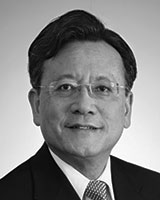Session 2a: Technological Advances in Asia
Chair: SawTeen See, See Robertson Structural Engineers, LLC
Speakers
Click a presenter to see a video of their presentation, and the accompanying paper and PowerPoint presentation.

Jong-Ho Kim
CEO & ChairmanChang Minwoo Structural Consultants
“Structural Design of the Jamsil Lotte World Tower”

Billy Howell
Project ExecutiveTurner Construction Company
“Logistical Challenges of Building the World’s Tallest Statue”

Dennis Poon
Managing PrincipalThornton Tomasetti, Inc.
“A Non-Coplanar Exoskeleton Supertall for Chengdu”
Session Summary
Asia has come to the forefront of tall building design, largely because teams of developers, architects, and engineers in the region are experimenting with new forms and methodologies that are reliant on innovative technologies. Each of the three speakers discussed projects that are in various stages of development, and the technological solutions that elevated their projects from ambitious ideas to models for future development.
Jong-Ho Kim CEO & Chairman, Chang Minwoo Structural Consultants, began the session by introducing the structural components of the Jasmil Lotte World Tower. Due to its location in the earthquake-prone region of Seoul, the tower uses a unique combination of lateral load resisting structural elements. Kim described in detail the various components that have been included in the tower, beginning with the foundation and working up towards the diagrid “lantern” structure, which functions as a crown for the building. He explained the rationale behind the inclusion of each individual structural component, and provided several examples of solutions that were left out of the final design.
William Howell, Project Manager, Turner International, followed up with a presentation on the logistical and structural challenges of constructing the world’s tallest statue at 182 meters, being constructed in the Narmada District of Gujarat, in honor of Sardar Vallabhbhai Patel, a former Deputy Prime Minister of India celebrated for his unification efforts in the region. The lack of easy access to the building site due to its remote location, and the local area’s rough terrain are both significant challenges to delivering construction materials to the site.
Howell informed attendees of an interesting campaign that will tie the statue into the culture of India, explaining "As part of a means of connecting the people, and particularly the farmers of India, with this Indian national monument, there's been a nationwide LOHA campaign in which iron tools have been collected from farmers around India with the intent of them being melted and converted into rebar for use in the statue's structure. Therefore the people and the farmers of India will be integrally linked with this statue."
The statue’s design is unique for it exposed feet and legs, whereas the world’s tallest statues tend to hide lower extremities, presents the significant structural challenge of having inverse proportions. The structural solutions to this issue were two cylindrical RC cores to match diameter of legs, and a steel space frame to support cladding.
Dennis Poon, Vice Chairman of Thornton Tomasetti delivered the final presentation, characterizing the challenges of designing a non-coplanar exoskeleton for the supertall Chengdu Greenland Tower in Chengdu. The 468-meter mixed-use main tower features a distinctive multi-faceted surface that breaks the exterior into adjacent triangles located on uneven planes. This design uses columns, bracing, and spandrel beams to produce a non-coplanar exoskeleton. The challenges and advantages of this system include irregular floor plans and integrated lateral stability. Poon emphasized that “Building outrigger systems is time-consuming and so we continued redesigning and planning where to place outriggers, until finally we had three levels of outrigger systems instead of four. We saved 700 tons of steel and another month of construction this way.”




